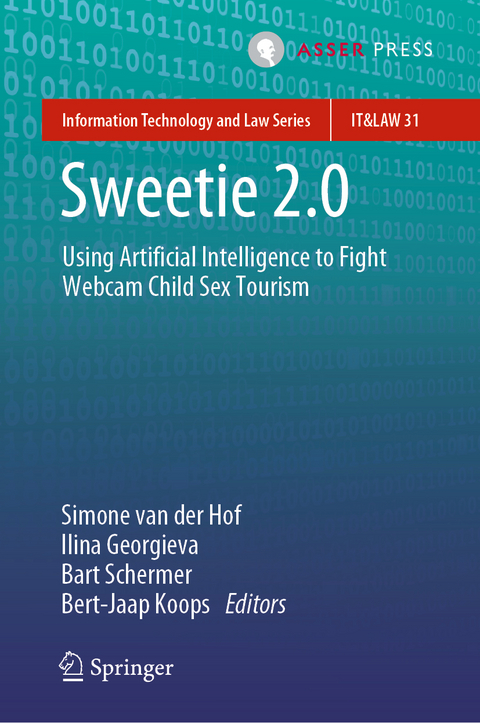
Sweetie 2.0
T.M.C. Asser Press (Verlag)
978-94-6265-287-3 (ISBN)
Terre des Hommes set out to actively tackle webcam child sex tourism by employing a virtual 10-year old Philippine girl named Sweetie, a so-called chatbot, to identify offenders in chatrooms. Sweetie 1.0 could bedeployed only if police officers participated in chats, and thus was limited in dealing with the large number of offenders. With this in mind, a more pro-active and preventive approach was adopted to tackle the issue. Sweetie 2.0 was developed with an automated chat function to track, identify and deter individuals using the internet to sexually abuse children. Using chatbots allows the monitoring of larger parts of the internet to locate and identify (potential) offenders, and to send them messages to warn of the legal consequences should they proceed further.
But using artificial intelligence raises serious legal questions. For instance, is sexually interacting with a virtual child actually a criminal offence? How do rules of criminal procedure apply to Sweetie as investigative software? Does using Sweetie 2.0 constitute entrapment? This book, the outcome of a comparative law research initiative by Leiden University’s Center for Law and Digital Technologies(eLaw) and the Tilburg Institute for Law, Technology, and Society (TILT), addresses the application of substantive criminal law and criminal procedure to Sweetie 2.0 within various jurisdictions around the world.
This book is especially relevant for legislators and policy-makers, legal practitioners in criminal law, and all lawyers and academics interested in internet-related sexual offences and in Artificial Intelligence and law.
Professor Simone van der Hof is General Director of Research at t he Center for Law and Digital Technologies (eLaw) of the Leiden Law School at Leiden University, The Netherlands. Ilina Georgieva, LL.M., is a PhD researcher at the Faculty of Governance and Global Affairs at Leiden University, Bart Schermer is an associate professor at the Center for Law and Digital Technologies (eLaw) of the Leiden Law School, and Professor Bert-Jaap Koops is Professor of Regulation and Technology at the Tilburg Institute for Law, Technology, and Society (TILT), Tilburg University, The Netherlands.
Chapter 1. Legal Aspects of Sweetie 2.0.- Chapter 2. Sexual-Orientated Online Chat Conversations - Characteristics and Testing Pathways.- Chapter 3. Sweetie 2.0 Technology: Technical Challenges of Making the Sweetie 2.0 Chatbot.- Chapter 4. Substantive and Procedural Legislation in Australia to Combat Webcam-Related Child Sexual Abuse.- Chapter 5. Substantive and Procedural Legislation in Belgium to Combat Webcam-Related Sexual Child Abuse.- Chapter 6. Substantive and Procedural Legislation in the Republic of Croatia to Combat Webcam-Related Child Sexual Abuse.- Chapter 7. Substantive and Procedural Legislation in England and Wales to Combat Webcam-Related Child Sexual Abuse.- Chapter 8. Substantive and Procedural Legislation in Estonia to Combat Webcam-Related Child Sexual Abuse.- Chapter 9. Substantive and Procedural Legislation in Israel to Combat Webcam-Related Child Sexual Abuse.- Chapter 10. Substantive and Procedural Legislation in the Netherlands to Combat Webcam-Related ChildSexual Abuse.- Chapter 11. Substantive and Procedural Legislation in the Philippines to Combat Webcam-Related Child Sexual Abuse.- Chapter 12. Substantive and Procedural Legislation in United States of America to Combat Webcam-Related Child Sexual Abuse.
| Erscheinungsdatum | 24.07.2019 |
|---|---|
| Reihe/Serie | Information Technology and Law Series ; 31 |
| Zusatzinfo | 8 Illustrations, color; 12 Illustrations, black and white; XVI, 542 p. 20 illus., 8 illus. in color. |
| Verlagsort | The Hague |
| Sprache | englisch |
| Maße | 155 x 235 mm |
| Themenwelt | Mathematik / Informatik ► Mathematik ► Finanz- / Wirtschaftsmathematik |
| Recht / Steuern ► EU / Internationales Recht | |
| Recht / Steuern ► Privatrecht / Bürgerliches Recht ► IT-Recht | |
| Recht / Steuern ► Strafrecht ► Kriminologie | |
| Schlagworte | Artificial Intelligence • Chatbot • Criminal Law • Criminal Procedure • Entrapment • Human Rights • Jurisdiction • Online sexual child abuse • Sweetie • Webcam |
| ISBN-10 | 94-6265-287-2 / 9462652872 |
| ISBN-13 | 978-94-6265-287-3 / 9789462652873 |
| Zustand | Neuware |
| Haben Sie eine Frage zum Produkt? |
aus dem Bereich


